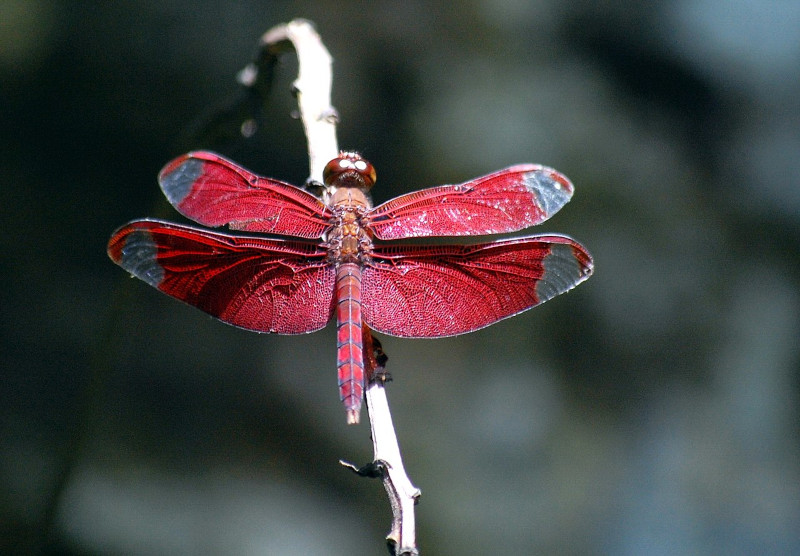
CCL: https://tinyurl.com/yswn2ycv
Fulvous Skimmer Facts
- The intriguing name of Fulvous Skimmer servers as the most frequently used common name for this striking winged wonder of Nature. Yet, the marvel does have at least one other general title that it’s known by. That, though, is the closely related term of fulvous forest skimmer.
- Within the world of science, however, it’s possibly much better known by its technical designation. That’s a somewhat difficult moniker for the average layperson to pronounce, though. That’s because the gorgeous invertebrate holds the official epithet Neurothemis fulvia.
- The dazzling creature received that hard-to-pronounce appellation due to the efforts of Dru Drury. The respected English entomologist accomplished the first acknowledgement of it as a separate and distinct species. He managed that scientifically noteworthy feat in 1773.
- Fortunately, the beautiful Fulvous Skimmer appears to be maintaining an overall population base that’s both stable and sufficient across its range. Due to this, the IUCN currently lists the wonder as Least Concern on its Red List. Yet, everything still isn’t perfect for the insect.
- That’s true since, in various scattered locations, local conditions occasionally cause population densities to plummet. Degradation of their native habitat due to occurences linked to humans such as deforestation and urbanization regularly pose challenges to their populations.
- This remarkable product of Nature and evolution clearly faces the same severe threats to its continued existence as all other species on earth today. Most of those dangers, like these, stem from the actions of mankind. Along with others, it also faces the danger of climate change.
Related Articles
Hines Emerald Dragonfly
Fulvous Skimmer Physical Description
The amazing Fulvous Skimmer rarely fails to immediately capture the attention of those people lucky enough to meet one of these natural beauties. Unlike some of its countless cousins, however, it does so due to both beauty and size. That’s because it represents a medium-sized dragonfly.
In terms of physical description, though, the magnificent Arthropod does follow a well-established pattern common among its kindred. That’s the fact that it displays a certain amount of the physiological characteristic of sexual dimorphism. In its case, this manifests itself in coloring.
In size, however, the two sexes of this amazing species present the same general shape and pattern. The average total length measures approximately 1.4 – 1.8 in (3.5 -4.5 cm). That extent includes both the thorax and abdomen, of course, but excludes appendages such as the legs and antennae.
In each gender, the thorax and abdomen each display the same general physical structure. That consists of the elongated shape typical of all known dragonflies. The abdomen frequently, though not necessarily, presents multiple small darker markings or patterns of coloring, regardless of sex.
As mentioned previously, it’s the stunning coloring that distinguishes the genders of the gorgeous Fulvous Skimmer. The male typically has a reddish-brown or reddish-yellow thorax and abdomen. The wings show transparent with a slight amber hue. The eyes usually appear as bright red.
Females of the species, meanwhile, typically display as somewhat duller in color compared to their male counterparts. These generally develop a slightly more brownish thorax and abdomen. They also more commonly have a slight reddish hue. Like the males, their wings develop as transparent.
One more feature sets the sexes apart in this astonishing work of art, however. As remains normal for its kind, the eyes evolved as compound in nature. In its case, these also developed as relatively prominent. But, these usually show as red in color in the males and brown in the females.
- Kingdom: Animalia
- Phylum: Arthropoda
- Class: Insecta
- Order: Odonata
- Family: Libellulidae
- Genus: Neurothemis
- Species: N. fulvia
Fulvous Skimmer Distribution, Habitat, and Ecology
The stunning Fulvous Skimmer developed as indigenous to a moderately broad swathe of the surface of the earth. The location and extent of that expansive zone of habitation, however, probably won’t surprise many people. That’s because the Arthropod evolved as native to part of Asia.
Yet, within the confines of that greater overall range, this remarkable creature still remains restricted to only certain regions. Due to this limitation, the majority of its numbers dwell within the borders of certain countries. These include India, Bangladesh, Myanmar, and Thailand, among others.
Fortunately, evolution provided this marvel with a high degree of flexibility regarding its choice of habitat. It therefore resides in a surprisingly wide range of ecosystems. Each of these locations, though, are typically characterized by the presence of freshwater bodies and dense vegetation.
It’s often found in abundance in forested regions, particularly situated near slow-moving streams, rivers, and other freshwater bodies within or adjacent to forests. The insect’s also quite frequently found in the area where these areas interface with these, generally known as the riparian zone.
It also often appears within regions formed of wetlands, marshes, and swamps, where there’s a mix of open water and vegetation. This species also inhabits ponds and lakes, especially those surrounded by dense vegetation. It even appears in rice paddies, agricultural fields, and parks.
Like all dragonflies everywhere, the visually vibrant Fulvous Skimmer feeds as a pure carnivore, hunting in a predatory manner. The remarkable invertebrate also generally preys on an extensive variety of locally available small prey, mainly including flies, mosquitoes, and other flying insects.
It also reproduces via a typical dragonfly life cycle, with the eggs being laid in or near freshwater. Females deposit eggs in either aquatic vegetation or directly into the water. After hatching, the larvae live in the water and undergo several distinct stages of development before emerging as adults.
Species Sharing Its Range
Check out our other articles on 4 Radiant Red Sea Creatures, Japanese Dwarf Flying Squirrel, Millaa Millaa Falls, Rosy Veincap, Rose’s Ghost Frog, Eurasian Griffin Vulture, Jamaican Iguana
